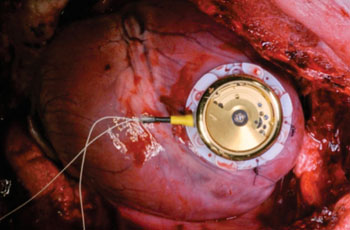Heart Motion Powers Novel Cardiac Pacemaker
By HospiMedica International staff writers
Posted on 18 Sep 2014
A prototype batteryless pacemaker is based on an automatic wristwatch winding movement, with all unnecessary parts removed to reduce weight and size.Posted on 18 Sep 2014
Developed by Adrian Zurbuchen, a PhD candidate in the cardiovascular engineering group at the University of Bern (Switzerland), the prototype works the same way it would on a person’s wrist; when exposed to an external acceleration, the eccentric mass of the clockwork starts rotating. This rotation progressively winds a mechanical spring, which unwinds once fully charged, spinning an electrical microgenerator and electronic circuit to charge a small buffer capacity. The researchers also developed a custom-made housing with eyelets that allows suturing the device directly onto the myocardium.

Image: The energy harvesting device sutured directly onto the myocardium (Photo courtesy of Adrian Zurbuchen / University of Bern).
To test the prototype, the researchers connected it to a custom-made cardiac pacemaker which was implanted in domestic pigs. The combined system first harvested the acquired energy from the heart; the energy was then temporarily stored in the buffer capacity; and finally, the buffered energy was used by the pacemaker to stimulate to the heart. The pacemaker allowed the researchers to pace the pigs’ hearts at 130 beats per minute. The prototype device was presented at the annual European Society of Cardiology (ESC) congress, held during August-September 2014 in Barcelona (Spain).
“The heart seems to be a very promising energy source because its contractions are repetitive and present for 24 hours a day, 7 days a week. Furthermore, the automatic clockwork, invented in the year 1777, has a good reputation as a reliable technology to scavenge energy from motion,” said Adrian Zurbuchen. “The next step in our prototype is to integrate both the electronic circuit for energy storage and the custom-made pacemaker directly into the harvesting device. This will eliminate the need for leads.”
“Our new pacemaker tackles the two major disadvantages of today’s pacemakers. First, pacemaker leads are prone to fracture and can pose an imminent threat to the patient. And second, the lifetime of a pacemaker battery is limited,” added Mr. Zurbuchen. “Our energy harvesting system is located directly on the heart and has the potential to avoid both disadvantages by providing the world with a batteryless and leadless pacemaker.”
Related Links:
University of Bern














